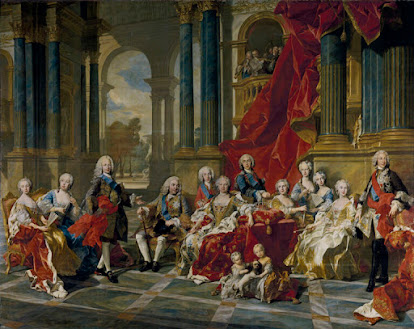French Baroque and the Royal Family of Philip V
The Family of Philip V by Louis-Michel van Loo
THE ART
The portrait of The Family of Philip V by Louis-Michel van Loo in 1743, was created in France. It is an oil on canvas painting with dimensions of 408 x 520cm. As this portrait portrays the family of the Spanish king and members, they are all wearing extravagant clothing. The background remains dramatic and royally sought with Roman arches and columns and a marble floor with dimensional designs. The style is influenced by the greco-roman elements of architecture. This architecture is noticed by the "symmetry, grace, and synchronicity" (Blueprint) created by stone, bricks or cement.
As they are all of the royal family in a gathering this portrait portrays the different attitudes that you can see on each of their faces. For example, the exhaustion of Philip V, dominance from his wife Isabelle Farnese, unawareness of confidence by Charles III and so on. While some also believe that the "artist is making a connection between the royal family and the Roman empire." (Scholarblogs) As they were a very powerful Spanish family it was known that the Baroque era of art became popular amongst royals. So this painting is a representation of royalty and their power as well as the continuation of that through their large family.
ANALYSIS
I have never been one to particularly enjoy still-life paintings. Although I have the exception of amazing portraits like this one. The detail and realism is what draws the eye to it. The color palette of this piece is what also makes it feel royal and beautiful. I have always found an interest in old roman times and the way society was back then. I can just imagine the power the Family of Philip had. Elements like tone, texture, color, linework is all shown within this piece. The different tones within each of their clothing and within the background give it a subtle feeling while keeping focus on the family. Texture is seen throughout within the curtains in the back, the ruffles within the clothing and within their hair. While the color palette of this piece is incredible as the chosen colors give it that royal feeling. Adding a lot of red and viewing it screams royal upon looking, and the usage of making their hair white adds that pop to keep you engaged. Linework and symmetry is seen a lot within the background of the family, as mentioned that this greco-roman style was popular during this time. You can also see it within the columns and arches seen behind the family.
BAROQUE ERA AND THE INFLUENCE OF THE ROYAL
The baroque era was not known to be complimented once introduced. It was the use of classical ancient times but with no restraint. The art within this era was seen as dramatic, realistic, creating illusion, and theatric. Also seen as a switch into humanity and realism for not just the wealthy but patrons as well. Genre paintings became widely spread through the visual arts and subject matter. These consisted of depicted scenes, landscape, and portraits for all types of people within that era.
The baroque art began to be popular within the royal courts and families and it was a show power and wealth to own a baroque art piece. Baroque art was the symbolization of "emerging power of new monarchies." (hsparhawk) These families weren't just getting portraits done to show wealth but it was also to impress visitors that would come into their palaces. As baroque art had a specific style to it, it was also shown through architecture, especially royals. Royals began using greco-roman styles through their courts, rooms, and upon entrance. The baroque era and royalty go hand in hand as the baroque artistic style influenced much of the royalties.
MY OPINION
The baroque era of art was very interesting as it consisted of nudity, still life, landscapes and more. As mentioned I am not much of a still-life painting type of person as I don't find there to be an interesting meaning behind them. Although upon learning about portraits like this one, its intriguing to see that things like royalty and art go hand in hand. I would love to see paintings like this in person as well as the architecture that was created during this period as well.
COMPARISON BETWEEN THE RENAISSANCE AND BAROQUE ERA
References:
“Spanish Royal Art During the Baroque Period.” Global Baroque Art, Scholarblogs, 2024, scholarblogs.emory.edu/globalbaroque/spanish-royal-art-during-the-baroque-period/.
“The Family of Philip V.” History Lab, 19 Feb. 2022, historylab.es/the-family-of-philip-v/.
“The Family of Philip V.” Museo Nacional Del Prado, www.museodelprado.es/en/the-collection/art-work/the-family-of-philip-v/ff667d13-323f-48cc-8923-4a6245e02f1f.
hsparhawk. “Baroque Era: The Influence of Royalty.” Mermaid Tails, 29 Sept. 2016, sparhawkbysea.wordpress.com/2016/09/29/baroque-era-the-influence-of-royalty/.
“Greco-Roman Architecture.” Blueprint, 2024, blueprint.ozpropertygroup.com.au/greco-roman-architecture/#:~:text=Washington%20D.C%2C%20US.-,Symmetry%2C%20grace%20and%20synchronicity%20typify%20this%20architectural%20form.,lintels%20typify%20Greco%2DRoman%20construction.




Comments
Post a Comment